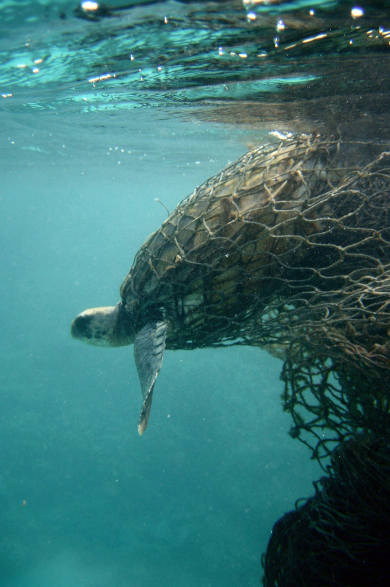Net work to spread word of grisly ghost deaths
 Aboriginal artists will work on a powerful new sculpture, formed out of the remnants of recent exploitation.
Aboriginal artists will work on a powerful new sculpture, formed out of the remnants of recent exploitation.
The piece will be made out of ghost nets; torn and broken chunks of net that are left or dumped by fishing vessel around the country.
Ghost nets kill masses of marine animals in local waters, and their deadly legacy will soon go on show at the Australian Museum.
Australia Museum curator Dr Scott Mitchell has commissioned the artists on remote Darnley Island (also known as Erub), to make one of their works for a mainland audience.
Dr Mitchell says the Darnley Island artists are becoming well-known for the big sculptural pieces make from ghost nets.
“If you come to the Australia Museum in Sydney you can see four of their pieces on display,” he told the ABC.
“We were able to commission them last year, very very large sculptural pieces; a fish called Garom and the crab called Dauma... which is a traditional story from the island about a fish and a crab who live on the reef and get married.
“All the animals come to the wedding... it's lovely, they call it ‘a dancing fleet’, a great shimmering mass of animals singing and dancing as they come to this celebration.
“And so these big sculptural works and the film that we've got and the song that they've recorded, all tell the story of this lovely event.
“But of course there's a very sad and serious environmental issue behind it.
“Ghost-net, when it gets dumped in the water doesn't break down.
“It usually doesn't sink, it continues to float around, and does what it was designed to do which is to kill marine life.
“There are about 200 species that are known to get tangled up in and killed by these things.
“They drag on reefs and other sensitive areas of sea bed.
“They're also a hazard to people. They get tangled up in the propellers of small boats that Aboriginal people use in that part of the world.
“It's mind-boggling to think an individual piece of net can be six or seven kilometres long, and that is a lot of wasteful, pointless destruction.
“But it's not all bad news certainly.
“Across the Gulf of Carpentaria and Torres Strait, Aboriginal communities have been leading efforts, to deal with this problem.
“I can't think of a community that's not involved in that part of the world through their Caring for Country programs, or their ranger programs.
“They get out there every year and they're pulling the net out up off the beach.
“They're pulling it out of the water.
“Artists have been involved: obviously by making these works like Duama and Garom, they're looking to raise awareness amongst the community about the problem.
“And also the local fishing industry in the Gulf of Carpentaria, the local industry has made a lot of progress in reducing the amount of net lost in the sea.”








 Print
Print